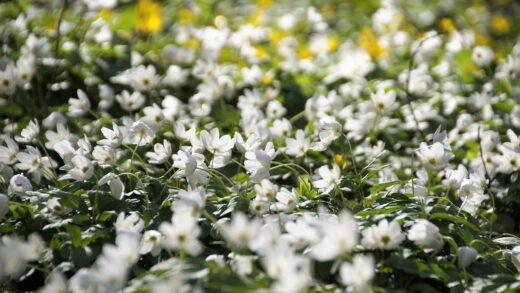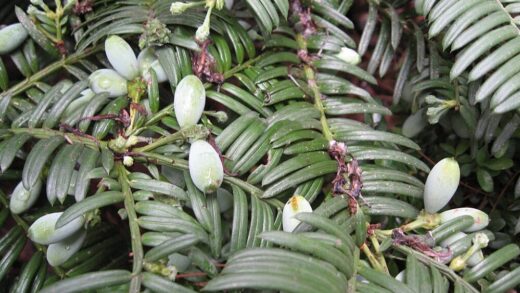As an evergreen shrub native to the woodlands of Europe, Daphne laureola is naturally well-equipped to handle temperate winter conditions. It is generally considered hardy and can withstand periods of frost and cold temperatures without significant issue, provided it is planted in a suitable location. The key to successful wintering lies not in elaborate protection schemes, but in ensuring the plant is healthy and well-established heading into the colder months. A spurge laurel situated in a sheltered spot with excellent soil drainage will be far more resilient to winter’s challenges than an exposed or waterlogged plant.
The primary threats to spurge laurel during winter are not just the cold itself, but a combination of factors including frozen ground, winter sun, and drying winds. When the ground is frozen solid, the plant’s roots are unable to take up water. If this coincides with bright, sunny days or strong, dry winds, the evergreen foliage can continue to lose moisture through transpiration, a process known as desiccation. This can lead to the leaves turning brown and brittle, a condition often mistaken for simple frost damage. Therefore, protecting the plant from winter wind and sun is often more important than insulating it from the cold.
A crucial aspect of winter preparation happens long before the first frost. It is vital to cease all fertilising by late summer. Applying fertiliser late in the season can encourage a flush of new, tender growth that will not have sufficient time to harden off before winter arrives. This soft growth is extremely susceptible to frost damage and can provide an entry point for diseases. Allowing the plant to slow its growth naturally and prepare for dormancy is an essential part of its winter survival strategy.
For plants growing in the ground, a layer of organic mulch applied in the autumn is one of the most beneficial things you can do. A two to four-inch layer of shredded leaves, composted bark, or wood chips spread over the root zone acts as a natural insulator. This helps to protect the roots from the most extreme temperature fluctuations, prevents the soil from freezing as deeply, and conserves residual moisture. This simple step mimics the protective blanket of fallen leaves that the plant would experience in its native woodland habitat, providing a significant buffer against the harshest winter weather.
Understanding winter hardiness
The inherent hardiness of Daphne laureola is a product of its evolutionary history. Having adapted to survive in temperate climates with distinct seasons, it has developed physiological mechanisms to cope with freezing temperatures. During the autumn, as days shorten and temperatures cool, the plant undergoes a process of acclimation. It gradually reduces the amount of water in its cells and increases the concentration of sugars and other solutes, which effectively acts as a natural antifreeze, lowering the freezing point of the cell sap and protecting the tissues from damage by ice crystals.
More articles on this topic
This natural hardiness means that for most gardens within its suitable growing zones, mature and well-established plants require very little in the way of special winter protection. The plant’s ability to withstand cold is, however, directly related to its overall health. A plant that has been stressed during the growing season by drought, poor nutrition, disease, or incorrect siting will enter winter in a weakened state and will be far more vulnerable to damage from cold, wind, and desiccation. This underscores the importance of proper year-round care in ensuring winter survival.
It is also important to understand the concept of microclimates within your own garden. A spurge laurel planted in a location sheltered by a wall or other evergreen plants will be protected from the worst of the winter winds and may experience temperatures several degrees warmer than a plant in an open, exposed position. Conversely, a plant situated in a low-lying frost pocket, where cold air naturally settles, will be subjected to more extreme cold. Choosing a planting site with winter conditions in mind is a key part of ensuring its long-term success.
The age of the plant also plays a role in its winter hardiness. A young, newly planted spurge laurel will be more vulnerable during its first winter than a mature, well-established specimen with a deep and extensive root system. For this reason, it can be beneficial to provide some extra protection for a plant during its first one or two winters in the garden. This might include applying a thicker layer of mulch or creating a temporary windbreak to help it through this initial vulnerable period until it is fully established.
Preparing garden plants for cold
Preparation is key to helping your in-ground Daphne laureola navigate the winter months successfully. The process should begin in the autumn, well before the first hard frost is expected. One of the most important steps is to ensure the plant is adequately hydrated before the ground freezes. If the autumn has been dry, provide a few deep, thorough waterings to allow the soil and the plant to become fully hydrated. A well-hydrated plant is much more resilient to the drying effects of winter winds and frozen ground than one that is suffering from drought stress.
More articles on this topic
Applying a generous layer of organic mulch is the next crucial step. After the ground has cooled but before it freezes solid, spread a two to four-inch layer of insulating material over the root zone. Excellent choices for mulch include shredded leaves, pine needles, composted bark, or straw. This layer will help to regulate the soil temperature, preventing the rapid and deep freezing that can damage roots. It also helps to conserve soil moisture and will gradually break down to enrich the soil over time. Be careful not to pile the mulch directly against the plant’s stem, which could encourage rot.
For plants in particularly windy or exposed locations, creating a temporary windbreak can be highly effective at preventing winter desiccation. This can be as simple as erecting a screen of burlap or horticultural fleece stapled to stakes placed on the windward side of the plant. The goal is not to completely enclose the plant, which can trap moisture and lead to disease, but simply to deflect the prevailing winter winds. This simple barrier can make a significant difference in protecting the evergreen foliage from windburn.
Throughout the winter, it is generally best to take a hands-off approach. Avoid the temptation to prune the plant during the winter months. Any pruning cuts can create wounds that may not heal properly in the cold, providing an entry point for diseases. Also, refrain from knocking heavy snow or ice off the branches unless there is a clear and immediate danger of them breaking under the weight. The snow itself can act as an excellent natural insulator, protecting the foliage and buds from the even colder temperatures and winds above.
Overwintering in containers
Overwintering a Daphne laureola in a container requires a different approach than for a garden-planted specimen. The primary reason for this is that the root system in a container is far more exposed to the cold. In the ground, the earth provides a huge amount of insulation, and the roots are protected from the rapid and extreme temperature fluctuations of the ambient air. In a pot, the roots are only separated from the freezing air by a thin layer of plastic, terracotta, or ceramic, making them much more vulnerable to freezing, which can be fatal.
The best strategy for overwintering a potted spurge laurel in a cold climate is to move it to a sheltered location. An unheated garage, a cold greenhouse, a shed, or a protected porch where temperatures will remain consistently cold but stay above the point of freezing the root ball solid is ideal. The goal is to keep the plant dormant, not to encourage it to grow, so a warm, indoor location is unsuitable. The plant still requires a period of winter cold to flower and grow properly the following season.
If moving the container is not feasible, you can take steps to insulate it in place. Grouping the container together with other pots can help to create a shared thermal mass. You can also wrap the container itself in layers of bubble wrap or burlap to provide insulation for the root ball. Another effective method is to ‘plunge’ the pot, which involves sinking the entire container into a vacant spot in a garden bed so that the surrounding soil insulates the roots naturally. You can then add a thick layer of mulch over the top of the pot and the surrounding soil for extra protection.
Watering is a critical aspect of overwintering container plants. The soil should not be allowed to dry out completely, but it is equally important not to overwater, as a waterlogged, frozen pot can kill the plant quickly. Check the soil moisture every few weeks. If the top few inches are dry, provide just enough water to lightly moisten the soil. Do this on a milder day when the water will be able to soak in rather than freezing instantly on the surface. Proper moisture management is key to bringing your potted spurge laurel through the winter successfully.
Post-winter assessment and care
As winter begins to recede and the first signs of spring appear, it is time to assess your Daphne laureola for any signs of winter damage and to prepare it for the new growing season. Wait until the threat of hard frosts has passed before taking any major action. The first step is to carefully inspect the plant. It is normal for a few older leaves to yellow and drop over the winter, but look for any branches that have died back completely or show significant browning and desiccation of the foliage.
Any branches that are clearly dead, brittle, and show no signs of life can be pruned out. Use clean, sharp secateurs and make your cuts back to a point where the wood is green and healthy, or remove the branch at its junction with a main stem. This tidying up not only improves the plant’s appearance but also removes dead material that could potentially harbor diseases. Avoid any major reshaping or heavy pruning; just focus on removing the winter-damaged parts.
Once you have done any necessary clean-up pruning, gently rake back the winter mulch from the base of the plant. This allows the sun to begin warming the soil, which encourages the plant to break dormancy and start its spring growth. This is also the perfect time to replenish the plant’s nutrition for the coming season. Apply a fresh two to three-inch layer of new organic mulch, such as garden compost or well-rotted leaf mould, over the root zone. This will provide a slow-release source of nutrients to support healthy new growth.
Monitor the plant’s watering needs as the weather warms up. The transition from winter dormancy to active spring growth is a time when the plant’s water requirements will increase significantly. Ensure the soil remains consistently moist but not waterlogged to support the flush of new leaves and the development of its fragrant spring flowers. With this simple post-winter care, your spurge laurel will be well-prepared to thrive throughout the coming year, rewarding you for your care with its unique and subtle beauty.
📷: Josep Gesti, CC BY-SA 4.0, via Wikimedia Commons


















